Sprekelia or sprekelia: care and reproduction
Of the Amaryllis family, Sprekelia is the only representative that has such an original color. The flower is rich, dark red, irregular in shape. In addition to its beautiful appearance, the flower also has a delicate exotic aroma.
Sprekelia formosissima, a beautiful sprekelia, bears similarities to tropical orchids. In Europe, it is called lilies, because according to legends, its flowers served as an ornament in civilized Indian cities.
Content:
Description of the plant
Shprekelia, often pronounced as sprekelia, came to our country from hot Mexico. And it is not for nothing that it bears the name of a magnificent spreckel. In various reference books for plant lovers, you can find another name:
- Lily of St. Jacob.
- Lily of the Knights Templar.
- Lily of the Aztecs.
Growing a plant in your garden, in the spring you can get beautiful red six-leaf flowers, sometimes yellow spots or stripes can appear, but they should not be scared.
The maximum plant height is 30 cm.
The bulb reaches 5 cm in diameter, has a black color, with rich red stripes. The number of leaves can vary from 3 to 6, they are flat, linear, up to 45 cm long and up to 2 cm wide. They have a dark green or gray color. Sprekelia blooms simultaneously with the appearance of green leaves or a little later.
The length of the peduncle is about 30 cm, it contains from 1 to 2 flowers.
When growing sprekelia at home in a pot, the main goal is to cut into bouquets and sell.
Sprekelia or Sprekelia is a versatile plant, because it can be grown both outdoors in the garden and at home in pots. It is important to observe agricultural technology similar to growing gladioli. If the climate is harsh and cold, then there is a high probability that the sprekelia will not be able to overwinter in the open field and will die. Therefore, it is very important, after the leaves wilted, to dig up the plant and let it overwinter in another place. For storage in winter, a temperature of +10 is suitable and it can be kept in such conditions until March.
The flower will stay fresh from several days to several weeks, it all depends on the conditions of maintenance and proper care.
Outdoor cultivation
The reproduction of sprekelia magnificent begins with buying bulbs... It is best to buy them in the spring, just before planting.
If sprekelia is grown in the garden, then you need to find a secluded place for it without drafts. All the necessary instructions for the planting site are indicated directly on the packaging with the bulbs:
- Optimal planting time: March-May.
- Planting depth of the bulb: 10 cm.
- Minimum distance between bulbs: 10 cm.
- Flowering will occur in May-August;
- Acceptable landing site: sunny.
- Add humus to the soil.
- The soil should not be too wet.
If March has already come, but the frost continues, then in no case should you start planting sprekelia. It is important to wait until the soil warms up and a stable warm temperature is established. Once this has happened and the bulbs have been planted in the soil, it is important to maintain a certain moisture level throughout the growth of the plant.
If frosty days suddenly come, but the sprouts need to be urgently protected.
Mulching of plantings with peat is recommended. You can foresee such an option in advance and mulch the sprouts immediately during planting. If the region in which the flowers will be grown is cold winters, then the bulbs will need to be dug out immediately after the end of the growing season.
When the leaves completely die off, the bulbs are dug up and cleaned of soil and dried tops. Under no circumstances should you cut off the roots on the bulbs. Bulbs are best preserved in dry peat in a cool room. If the temperature exceeds +10 degrees, there is a risk that the plant will begin to germinate ahead of time.
Water the plant should be about 2 times a week, if the air temperature is high and the humidity is low, then you can increase the amount of watering up to 3 times. Sprekelia is not afraid of water. If there is good drainage, then there is no danger of flooding. Do not be alarmed if the leaves turn yellow earlier than other plants.
Growing at home
As already mentioned, sprekelia can be grown at home as well. You need to plant the bulb in the same way as hippeastrum Experienced growers are probably familiar with this technology, even the diseases of these two flowers are similar.
To grow sprekelia, you need a tall pot, it must have a drainage hole in it. A large amount of drainage needs to be laid out on the bottom. The pot should not be spacious and wide, a diameter slightly wider than the bulb itself will be enough.
Better soil for growing sprekelia is a substrate of the following components:
- Sand.
- Peat.
- Sod land.
- Compost.
If in the garden the bulb settles to a depth of 10 cm, then in the pot, on the contrary, the bulb should look a little to the surface. The plant will grow very quickly, the bulbs will sprout immediately and the leaves and flower arrows will appear. As for watering, just like garden sprekelia, it is necessary to water it regularly, preventing the substrate from drying out.
Experts recommend mulching the soil with a large layer of sphagnum moss to keep the moisture in place longer.
The most comfortable side for the growth of sprekelia will be the southern one, but it is very important that there is no oppressive effect of direct sunlight. It is better to put the pot behind glass, but not in a shaded place. Florists noticed that the flower takes root well on the northwest side. That is, in the spring, it is better to put the pot on a sunnier side, and when hot weather begins, you can transfer it to a cooler one.
The first flowers open in early April. In hot weather, it will bloom for no more than a week, in a cooler environment up to a month.
You need to fertilize the plant in spring and summer twice a month. It is worth alternately applying complex mineral fertilizers and organic fertilizers during the entire active growth and flowering.
For the winter period, the bulb may not be removed from the pot, but watering should be stopped. The pot is transferred to a dry, cool, dark place in the apartment. Only if the state of dormancy is observed can we expect to bloom in the next season.
Other features of sprekelia
Florists most often use bulbs for propagation of sprekelia. In one season, an adult bulb will necessarily produce one small onion. In most cases, it quickly grows to standard size. If the plant has produced several onions, then all of them will be much smaller than the mother.
In the spring, during the sprekelia transplant, the newly formed bulbs should be separated.
Reproduction can be done with seeds, but it will take a very long time. Some may simply not have the patience. Freshly harvested seeds begin to germinate quickly. Within a month, they can be transplanted into small containers.In the first year, seedlings will not go dormant for autumn / winter, but they will develop rather slowly. In the second year, care for seedlings is the same as for adult plants. The main difference is that the seedlings begin to bloom no earlier than 5 years later.
If the air in the garden or at home is dry for a long time, then you can use a spray bottle and moisten the plant.
It often happens that pests attack sprekelia, the most common diseases and parasites are:
- Amaryllis bug.
- Mealybug.
- Bulb mite.
- Staganosporosis.
- Anthracnose.
- Fusarium.
- Red burn
- False shield.
The main reason is the violation of the conditions of detention. You can identify the disease of sprekelia by strokes and dots on the bulb or leaves. It is almost impossible to defeat the fungus, but as a preventive measure it is recommended to keep the upper part of the plant dry.
To get rid of the spread of other parasites, before planting the bulb, it is immersed in a solution of copper oxychloride (0.70%) for 15 minutes, and why is it well dried. If the plant is already actively growing, then its leaves can be sprayed with the same solution.
Sprekelia splendid fully lives up to its name. It is not that difficult to maintain, so it can be used to decorate your home and garden.



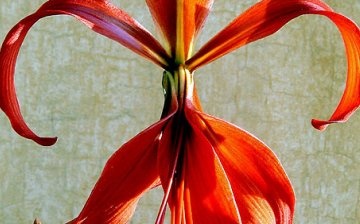
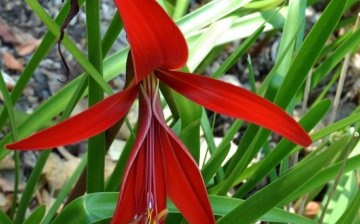
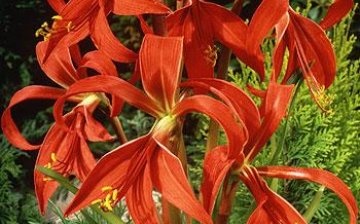
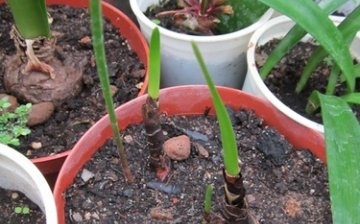
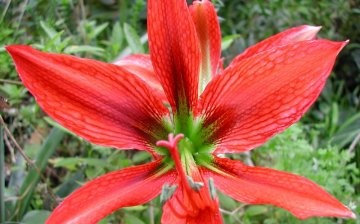





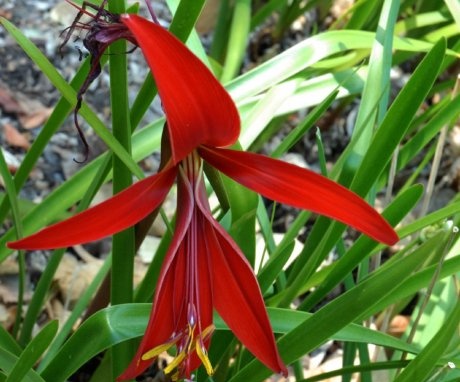
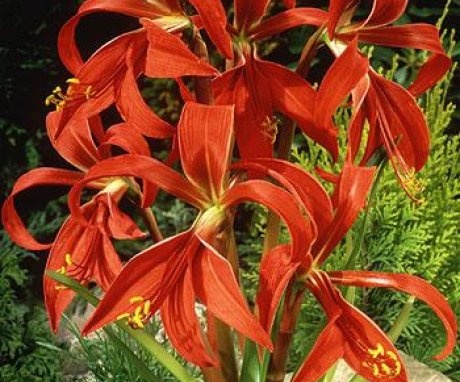
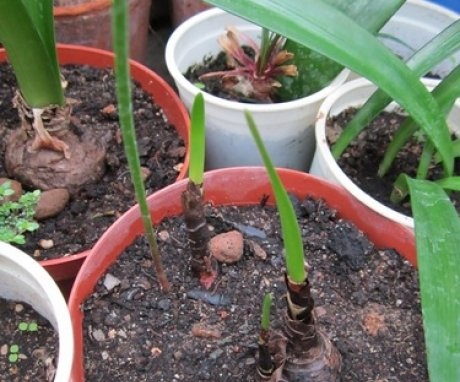
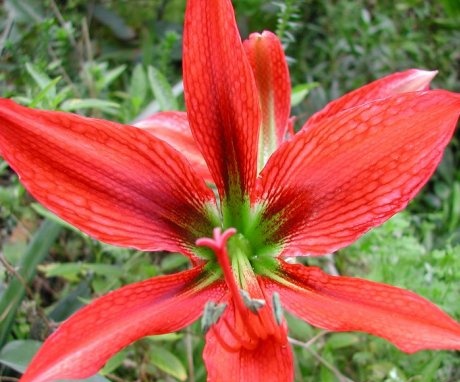
One little advice for those who love such plants - if there is an opportunity to find land from a dry river, so crumbly and peaty, then take it for planting. I used to plant in the proportions of 50x50, and then there was a lot of such soil and I stuck a bulb of sprekelia into it. The flower turned out to be so tall, with huge leaves and beautiful flowers. I think all this is due to the soil.